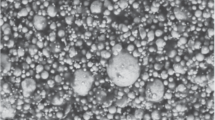Extrusion molding, varying the particle size and the conditions for obtaining corundum, was used to obtain ceramic block carriers. The structural and mechanical properties of the molding bodies were investigated, and the textural and strength characteristics of the blocks after calcination were determined. It was shown that the use of corundum powder obtained by mixing particles of different size results in the production of molding bodies of the first or fourth structural-mechanical type and makes it possible to produce ceramic block carrier with channel density about 200 pieces/inch2, mechanical strength at least 4.3 MPa, and high resistance to thermal cycling.




Similar content being viewed by others
References
L. A. Isupova, E. F. Sutormina, N. A. Kulikovskaya, et al., “Honeycomb supported perovskite catalysts for ammonia oxidation processes,” Catalysis Today, 105, 429 – 435 (2005).
Jürgen Neuman, The Catalyst and a Method of Decomposition of Dinitrogen Monoxide and a Method and Apparatus for Producing Nitric Acid, RF Patent 2397810. IPC-8, B01J23_10 [in Russian], published August 27, 2010.
Yu. V. Alekcandrova, E. A. Vlasov, N. V. Mal’tseva, et al., “Block articles with honeycomb structure made from of ceramic oxide, Pt. 1,” Ogneup. Tekh. Keram., No. 7 – 8, 62 – 66 (2010).
Z. R. Ismagilov, M. N. Shepeleva, R. A. Skrabina, and V. B. Fenelonov, “Interrelation between structural and mechanical characteristics of spherical alumina granules and the initial hydroxide properties,” Appl. Catal., 69, 65 – 73 (1991).
A. V. Zhensa, A. A. Polunin, E. M. Kol’tsova, et al., “Development of an information system for extrusion molding of catalytic pastes,” Khim. Prom. Segodnya, No. 9, 4 – 9 (2003).
I. A. Petropavlovskii, V. V. Kostyuchenko, V. A. Filipin, et al., “Characteristics of extrusion technology and application of aluminum-oxide catalysts with shaped grains,” Khim. Prom., No. 10, 19 – 23 (1997).
V. Yu. Kruglyakov, L. A. Isupova, A. V. Glazyrin, et al., “Investigation of the properties of molding bodies based on aluminum hydroxides for extrusion molding,” Kataliz v Prom-sti, No. 1, 6 – 12 (2016).
S. P. Nichiporenko, Physicochemical and Chemical Mechanics of Disperse Structures in Construction Ceramics Technology [in Russian], Naukova Dumka, Kiev (1968).
V. Yu. Kruglyakov, N. A. Kulikovskaya, and L. A. Isupova, “Rheological properties catalytic pastes of the block catalyst IK-42-1 as a function of the preparation conditions,” Kataliz v Prom-sti, No. 5, 41 – 49 (2008).
V. Yu. Prokof’ev, P. B. Razgovorov, and A. P. Il’in, Fundamentals of the Physicochemical Mechanics Extruded Catalysts and Sorbents [in Russian], Krasand, Moscow (2013).
A. P. Il’in and V. Yu. Prokof’ev Physicochemical Mechanics in the Technology of Catalysts And Sorbents [in Russian], Ivanovo State Chemical Technological Institute, Ivanovo (2004).
Z. R. Ismagilov, R. A. Shkrabina, and N. A. Koryabkina, Aluminum Oxide Carriers: Production, Properties, and Applications in Catalytic Processes in Environmental Protection [in Russian], SO RAN GPNTB; Inst. Kataliza im. G. K. Boreskova, Novosibirsk (1998) (Ekologiya, No. 50).
J. J. Benbow and J. Bridgwater, “On the prediction of extrudate pore structure from particle size,” Chem. Eng. Sci., 42(4), 753 – 766 (1987).
P. A. Rebinder, Physicochemical Mechanics of Disperse Structures [in Russian], Nauka, Moscow (1966).
Author information
Authors and Affiliations
Corresponding author
Additional information
Translated from Steklo i Keramika, No. 11, pp. 11 – 17, November, 2017.
Rights and permissions
About this article
Cite this article
Kruglyakov, V.Y., Sutormina, E.F., Kulikovskaya, N.A. et al. Influence of the Composition and Properties of Molding Bodies on the Characteristics of Corundum Block Carriers. Glass Ceram 74, 393–398 (2018). https://doi.org/10.1007/s10717-018-0002-0
Published:
Issue Date:
DOI: https://doi.org/10.1007/s10717-018-0002-0




